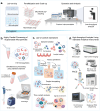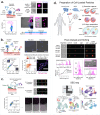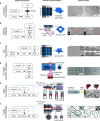Lab on a Particle Technologies
- PMID: 38650433
- PMCID: PMC11112544
- DOI: 10.1021/acs.analchem.4c01510
Lab on a Particle Technologies
Conflict of interest statement
The authors declare the following competing financial interest(s): D.D. and the Regents of the University of California have financial interests in Partillion Bioscience which is commercializing Lab on a Particle technology.
Figures









Similar articles
-
Flow lithography for structured microparticles: fundamentals, methods and applications.Lab Chip. 2022 Oct 25;22(21):4007-4042. doi: 10.1039/d2lc00421f. Lab Chip. 2022. PMID: 35920614 Review.
-
Recent advances in particle and droplet manipulation for lab-on-a-chip devices based on surface acoustic waves.Lab Chip. 2011 Apr 7;11(7):1280-5. doi: 10.1039/c0lc00527d. Epub 2011 Feb 8. Lab Chip. 2011. PMID: 21301739 Review.
-
Integrated lab-on-chip biosensing systems based on magnetic particle actuation--a comprehensive review.Lab Chip. 2014 Jun 21;14(12):1966-86. doi: 10.1039/c3lc51454d. Epub 2014 May 7. Lab Chip. 2014. PMID: 24806093 Review.
-
Operando investigation of particle re-entrainment mechanism in electrostatic capture process on the lab-on-a-chip.J Environ Sci (China). 2024 Feb;136:337-347. doi: 10.1016/j.jes.2022.12.013. Epub 2022 Dec 20. J Environ Sci (China). 2024. PMID: 37923443
-
Measurement of Aerosol Particles from Vibrated Lab Coats.Toxics. 2024 Aug 2;12(8):565. doi: 10.3390/toxics12080565. Toxics. 2024. PMID: 39195667 Free PMC article.
Cited by
-
Sealable capped nanovials for high-throughput screening of cell growth and function.bioRxiv [Preprint]. 2025 Jul 3:2025.06.29.662236. doi: 10.1101/2025.06.29.662236. bioRxiv. 2025. PMID: 40631199 Free PMC article. Preprint.
-
From specialization to broad adoption: Key trends in droplet microfluidic innovations enhancing accessibility to non-experts.Biomicrofluidics. 2025 Mar 3;19(2):021302. doi: 10.1063/5.0242599. eCollection 2025 Mar. Biomicrofluidics. 2025. PMID: 40046719 Free PMC article.
-
Construction of Multiplexed Assays on Single Anisotropic Particles Using Microfluidics.ACS Cent Sci. 2025 Jan 15;11(2):294-301. doi: 10.1021/acscentsci.4c02009. eCollection 2025 Feb 26. ACS Cent Sci. 2025. PMID: 40028365 Free PMC article.
-
Evaluation of industrial and consumer 3-D resin printer fabrication of microdevices for quality management of genetic resources in aquatic species.Micro Nano Eng. 2024 Sep;24:100277. doi: 10.1016/j.mne.2024.100277. Epub 2024 Jul 25. Micro Nano Eng. 2024. PMID: 39157761 Free PMC article.
-
Linking single-cell transcriptomes with secretion using SEC-seq.Nat Protoc. 2025 Jul;20(7):2034-2055. doi: 10.1038/s41596-024-01112-w. Epub 2025 Feb 20. Nat Protoc. 2025. PMID: 39979460 Review.
References
Publication types
Grants and funding
LinkOut - more resources
Full Text Sources
Miscellaneous

